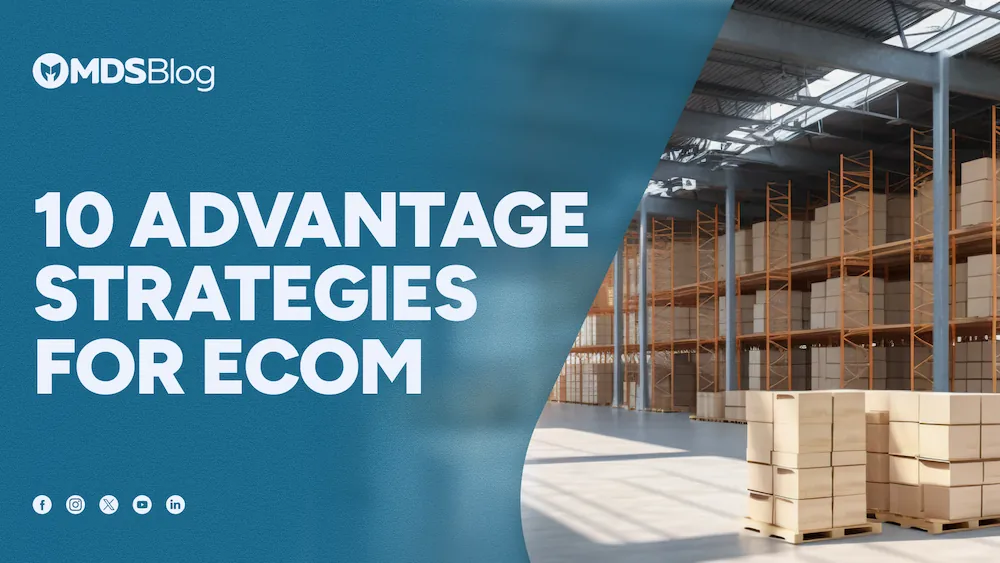Stay Updated with Everything about MDS
Thank you! Your submission has been received!
Oops! Something went wrong while submitting the form.

Chilat Doina
October 25, 2025
In the crowded e-commerce landscape, simply having a great product is no longer enough. The market is saturated, customer acquisition costs are soaring, and consumer expectations are at an all-time high. To not just survive but thrive, brands need a deliberate, well-executed plan to stand out. This requires moving beyond temporary tactics and building a sustainable edge that shields your business from market volatility.
True market leaders don't rely on luck; they build moats around their businesses using proven competitive advantage strategies. Before you can effectively implement any of these, you must first understand your rivals. A comprehensive competitor analysis framework provides the essential foundation, allowing you to identify gaps and opportunities in the market. This critical first step informs which strategies will deliver the highest impact for your specific brand.
This article breaks down ten of the most effective strategies you can implement, moving from high-level theory to the actionable steps needed to create lasting value. You will learn how to secure your market position through approaches like cost leadership, superior customer experience, and operational excellence. Each section offers a clear roadmap to build a resilient and profitable e-commerce business.
Cost leadership is one of the most powerful competitive advantage strategies, centered on a single goal: becoming the lowest-cost producer in your industry while maintaining acceptable quality. This isn't about being "cheap" but about being hyper-efficient. By minimizing operational expenses through economies of scale, superior technology, and streamlined processes, a brand can offer lower prices than competitors, attracting a large, price-sensitive customer base and capturing significant market share.

This strategy is famously executed by giants like Walmart, which leverages its immense purchasing power and world-class supply chain to offer "everyday low prices." For e-commerce brands, the principles remain the same. The focus shifts to optimizing every facet of the operation, from sourcing and production to warehousing and shipping.
Achieving cost leadership requires a relentless focus on efficiency across your entire business. Here are actionable steps to get started:
This strategy is most effective in markets with high price sensitivity and standardized products where differentiation is difficult. Learn more about effective cost reduction strategies to further refine your approach.
The differentiation strategy is one of the most powerful competitive advantage strategies, focusing on creating a unique product, service, or brand identity that is highly valued by customers. Instead of competing on price, businesses create superior value through innovation, exceptional quality, or a distinctive customer experience. This allows them to command premium prices, cultivate intense brand loyalty, and build a strong defense against competitors.

This approach is epitomized by brands like Apple, which differentiates through superior design, a seamless ecosystem, and an innovative user experience. For e-commerce brands, differentiation can be achieved through unique product features, compelling brand storytelling, or an unparalleled unboxing experience. The goal is to make your brand the only viable choice for a specific segment of the market.
Successful differentiation requires a deep understanding of your target customer and a commitment to delivering unique value. Here are actionable steps to build your strategy:
This strategy is highly effective in markets where customers are less price-sensitive and value quality, innovation, and brand image. It helps build long-term brand equity and reduces direct competition on price.
The focus or niche strategy is one of the most effective competitive advantage strategies for brands that want to dominate a specific segment rather than competing in the entire market. The goal is to cater to the unique needs of a narrow customer group, geographic area, or product line. By becoming the go-to expert in a specialized area, a company can build deep customer loyalty and fend off larger, more generalized competitors.
This approach is powerfully demonstrated by brands like Crunchyroll, which dominates the anime streaming market by super-serving a passionate fanbase, and REI, which focuses exclusively on outdoor enthusiasts with specialized gear and expertise. For e-commerce stores, a niche strategy allows you to connect with a dedicated audience on a deeper level, building a strong community and brand identity that broader retailers cannot replicate.
Successfully implementing a focus strategy requires deep understanding and commitment to a specific market segment. Here’s how to build your advantage:
This strategy is ideal for smaller or newer e-commerce brands that can't compete with giants on price or scale. By focusing your efforts, you can achieve profitability and establish a defensible market position.
Innovation and R&D Excellence is a forward-looking competitive advantage strategy focused on gaining a sustainable edge through continuous technological advancement and product development. This approach involves a significant, ongoing investment in creating new products, enhancing existing ones, and pioneering novel processes. By out-innovating competitors, a brand can establish itself as a market leader, command premium prices, and build a loyal customer base excited for its next release.

Tech giants like Google and pioneering companies like SpaceX are prime examples of this strategy in action. They consistently allocate vast resources to research and development, not just to improve current offerings but to invent entirely new markets. For e-commerce brands, this translates to developing unique products, patenting proprietary technology, or creating a genuinely new user experience that competitors cannot easily replicate.
Building an engine for innovation requires a cultural commitment and strategic investment. Here are key steps to foster R&D excellence:
This strategy is ideal for dynamic industries where technology and consumer preferences evolve rapidly. It helps brands move beyond competing on price and instead compete on value, novelty, and superior performance.
Building a competitive advantage through supply chain excellence means turning logistics from a cost center into a strategic weapon. This strategy focuses on creating a highly efficient, responsive, and resilient supply chain that reduces costs, speeds up delivery, and improves product quality. By optimizing everything from sourcing and inventory management to fulfillment and last-mile delivery, a brand can outperform competitors and create a superior customer experience.
This approach is exemplified by Amazon, whose world-class logistics and fulfillment network enables unparalleled delivery speeds. Similarly, Zara’s fast-fashion model relies on a highly responsive supply chain to move designs from runway to retail in weeks. For e-commerce brands, supply chain mastery is one of the most effective competitive advantage strategies for delighting customers and protecting margins.
Achieving a superior supply chain requires a deep commitment to data, collaboration, and continuous improvement. Here are actionable steps to build this advantage:
This strategy is crucial for e-commerce businesses where delivery speed and product availability are key differentiators. Discover more by exploring these supply chain management best practices to refine your operations.
Beyond price and product features, a powerful brand and an exceptional customer experience can form one of the most durable competitive advantage strategies. This approach focuses on building a strong emotional connection with customers, turning them into loyal advocates. Brands that master this can command premium prices, create significant switching costs, and foster a level of loyalty that competitors find nearly impossible to replicate.

This strategy is epitomized by companies like Disney, which creates magical experiences, and Starbucks, which built an empire around community and atmosphere, not just coffee. For e-commerce brands, this means creating a seamless, memorable, and personalized journey for every customer, from their first website visit to the unboxing of their order and beyond.
Building a beloved brand requires a deep commitment to your customer at every single touchpoint. Here are key actions to implement this strategy:
This strategy is highly effective for brands in crowded markets where creating an emotional bond, rather than competing on features alone, is the key to standing out and building long-term value.
Strategic partnerships are powerful competitive advantage strategies that involve collaborating with other businesses to achieve mutual goals. Instead of building every capability internally, companies can leverage external relationships to access new markets, share resources, and combine complementary strengths. This approach allows brands to innovate faster, expand their reach, and create unique value propositions that would be difficult to achieve alone.
This strategy is evident in collaborations like Spotify's licensing agreements with music labels, which give it a vast content library, or the Android ecosystem, where Google partners with numerous device manufacturers. For e-commerce brands, this could mean co-branding a product with an influencer or integrating another company's technology into your storefront to enhance the customer experience.
Building successful alliances requires careful planning and clear communication to ensure all parties benefit. Here are actionable steps to forge effective partnerships:
This strategy is ideal for brands looking to enter new markets, acquire new technologies, or enhance their product offerings without incurring the full cost and risk of internal development. Learn more about creating powerful brand collaborations by exploring guides on strategic partnership models.
Operational excellence is a powerful competitive advantage strategy that focuses on executing core business processes more effectively and reliably than competitors. It isn't just about cutting costs; it's about optimizing every step of your operation to deliver consistent quality, speed, and value to the customer. By refining processes, minimizing waste, and empowering employees, a brand can build a reputation for dependability and flawless execution that rivals can’t easily replicate.
This strategy is famously embodied by companies like Toyota with its world-renowned Production System, and FedEx, which built an empire on the promise of reliable overnight delivery. For e-commerce brands, operational excellence translates to faster order fulfillment, fewer shipping errors, superior quality control, and a seamless customer experience from checkout to unboxing.
Achieving operational excellence requires a deep commitment to continuous improvement and a culture that values precision. Here are actionable steps to get started:
This strategy is most effective for brands that compete in markets where reliability, speed, and consistency are critical factors in the customer’s purchasing decision.
In today's digital landscape, data is the new currency. This strategy involves leveraging advanced analytics, artificial intelligence (AI), and machine learning to gain deep insights into customer behavior, market trends, and operational performance. By making decisions based on data rather than intuition, brands can create a powerful competitive advantage through superior personalization, predictive accuracy, and strategic optimization.
This approach allows e-commerce businesses to anticipate customer needs, optimize pricing dynamically, and streamline their entire operation. Amazon is a prime example, using its sophisticated recommendation algorithms to personalize the shopping experience and drive sales. Similarly, Netflix uses viewing data to predict which content will resonate with its audience, informing its multi-billion dollar production budget.
Building a data-driven culture requires more than just tools; it requires a strategic mindset and a commitment to actioning insights. Here’s how to get started:
This strategy is most effective for businesses that can collect large volumes of high-quality data and are willing to invest in the technology and talent required to analyze it. By mastering data-driven approaches, you can stay several steps ahead of the competition. For a deeper dive, explore how to implement data-driven decision-making in your business.
Agility and adaptability are competitive advantage strategies focused on an organization's ability to respond swiftly and effectively to market changes. Instead of relying on a fixed, long-term plan, agile businesses build flexibility into their core operations. This allows them to pivot their products, processes, and strategies in response to emerging customer needs, competitive threats, or new technological opportunities, turning potential disruptions into a source of strength.
This approach is exemplified by companies like Netflix, which masterfully transitioned from a DVD-by-mail service to a global streaming and content production powerhouse. For e-commerce brands, agility means being able to quickly test new product lines, adjust marketing campaigns based on real-time data, and rapidly scale operations up or down to meet fluctuating demand, ensuring they are never left behind by a fast-moving market.
Building an agile organization requires a cultural shift towards speed, learning, and empowerment. Here are actionable steps to foster this capability:
This strategy is particularly effective in dynamic, unpredictable industries where customer preferences and technologies evolve quickly. It allows brands to capitalize on new opportunities before slower competitors can even react.
StrategyImplementation Complexity 🔄Resource Requirements ⚡Expected Outcomes ⭐📊Ideal Use Cases 💡Key Advantages ⭐Cost LeadershipHigh 🔄🔄🔄 — requires scale & process disciplineHigh ⚡⚡⚡ — capital, automation, supplier network⭐⭐⭐📊 Lower prices, larger market share, improved margins at scalePrice-sensitive mass markets, commoditized goodsCost advantage; resilience in downturnsDifferentiation StrategyHigh 🔄🔄🔄 — intensive R&D and brandingHigh ⚡⚡⚡ — R&D, marketing, design talent⭐⭐⭐⭐📊 Premium pricing, strong brand loyalty, reduced direct rivalryPremium products, innovation-driven industries, luxury marketsPricing power; customer loyaltyFocus / Niche StrategyMedium 🔄🔄 — targeted specializationMedium ⚡⚡ — specialist talent, tailored marketing⭐⭐⭐📊 Deep customer loyalty, higher margins within a small segmentNiche communities, regional markets, enthusiast segmentsDeep expertise; lower direct competitionInnovation & R&D ExcellenceVery high 🔄🔄🔄🔄 — complex long-term processesVery high ⚡⚡⚡⚡ — labs, talent, long timelines⭐⭐⭐⭐⭐📊 New products, entry into new markets, strong barriersTech, pharma, industries requiring breakthroughsSustainable differentiation; first-mover advantageSupply Chain Excellence & EfficiencyHigh 🔄🔄🔄 — complex coordination & systemsHigh ⚡⚡⚡ — tech, logistics, supplier integration⭐⭐⭐⭐📊 Lower operational costs, faster fulfillment, quality consistencyRetail, manufacturing, fast-fashion, large-scale distributionCost & lead-time reduction; operational resilienceBrand Strength & Customer ExperienceHigh 🔄🔄🔄 — long-term cultural effortMedium-High ⚡⚡⚡ — marketing, service training⭐⭐⭐⭐📊 Premium pricing, strong retention, advocacyConsumer brands, hospitality, premium servicesBrand equity; customer advocacyStrategic Partnerships & AlliancesMedium 🔄🔄 — coordination and governance neededMedium ⚡⚡ — partner management, legal/frameworks⭐⭐⭐📊 Accelerated capability, shared risk, market accessMarket entry, co-development, ecosystemsAccess to capabilities; faster time-to-marketOperational Excellence & EfficiencyMedium 🔄🔄🔄 — process redesign and change mgmtMedium ⚡⚡ — process tools, training, metrics⭐⭐⭐⭐📊 Consistent quality, lower costs, faster deliveryHigh-volume operations, logistics, service chainsReliability; cost-effective executionData Analytics & AI-Driven Decision MakingHigh 🔄🔄🔄 — data pipelines, models, governanceHigh ⚡⚡⚡ — data infra, talent, compliance⭐⭐⭐⭐📊 Personalization, prediction, optimized operationsE‑commerce, finance, logistics, personalization use casesData-driven optimization; predictive advantageAgility & AdaptabilityMedium 🔄🔄 — cultural and structural changeMedium ⚡⚡ — training, cross-functional tools⭐⭐⭐⭐📊 Faster pivots, continuous learning, resilienceRapidly changing markets, startups, digital transformationSpeed of response; improved innovation throughput
Navigating the crowded e-commerce landscape requires more than just a great product; it demands a deliberate, well-executed competitive advantage. We've explored ten powerful frameworks, from the foundational principles of Cost Leadership and Differentiation to the modern imperatives of Data Analytics and Agility. Each of these competitive advantage strategies offers a distinct path to market leadership, yet their true power is unlocked not in isolation, but in combination.
The most resilient brands don't just pick one strategy and stop. They create a unique, layered defense system. Think of combining the operational mastery of Supply Chain Excellence with the deep customer connection fostered by superior Brand Strength. Or leveraging a laser-focused Niche Strategy amplified by AI-Driven Decision Making to predict and meet customer needs before they even arise. This synthesis is what transforms a simple tactic into a formidable, long-term competitive moat that is incredibly difficult for rivals to replicate.
Understanding these concepts is the first crucial step, but turning theory into tangible results is where the real work begins. Your immediate task is to move from passive learning to active implementation. Don't try to master all ten strategies at once; that's a recipe for diluted effort and minimal impact. Instead, focus your energy where it will matter most.
Follow these steps to build your unique advantage:
The journey to building a dominant e-commerce brand is a marathon, not a sprint. The competitive advantage strategies you implement today will become the foundation for your growth tomorrow. It requires continuous refinement, a commitment to excellence, and the courage to make bold choices that set you apart from the competition. By thoughtfully selecting and masterfully executing the right strategies, you can transform your business from just another player into a market leader.
Executing at the highest level requires more than just a plan; it requires surrounding yourself with peers who are already doing it. If you're a top-tier entrepreneur ready to accelerate your growth by learning from the best, the Million Dollar Sellers community provides the exclusive network and high-level insights needed to turn ambitious strategies into market dominance. Discover how elite Amazon and e-commerce sellers build and scale their competitive advantages at Million Dollar Sellers.
Join the Ecom Entrepreneur Community for Vetted 7-9 Figure Ecommerce Founders
Learn MoreYou may also like:
Learn more about our special events!
Check Events